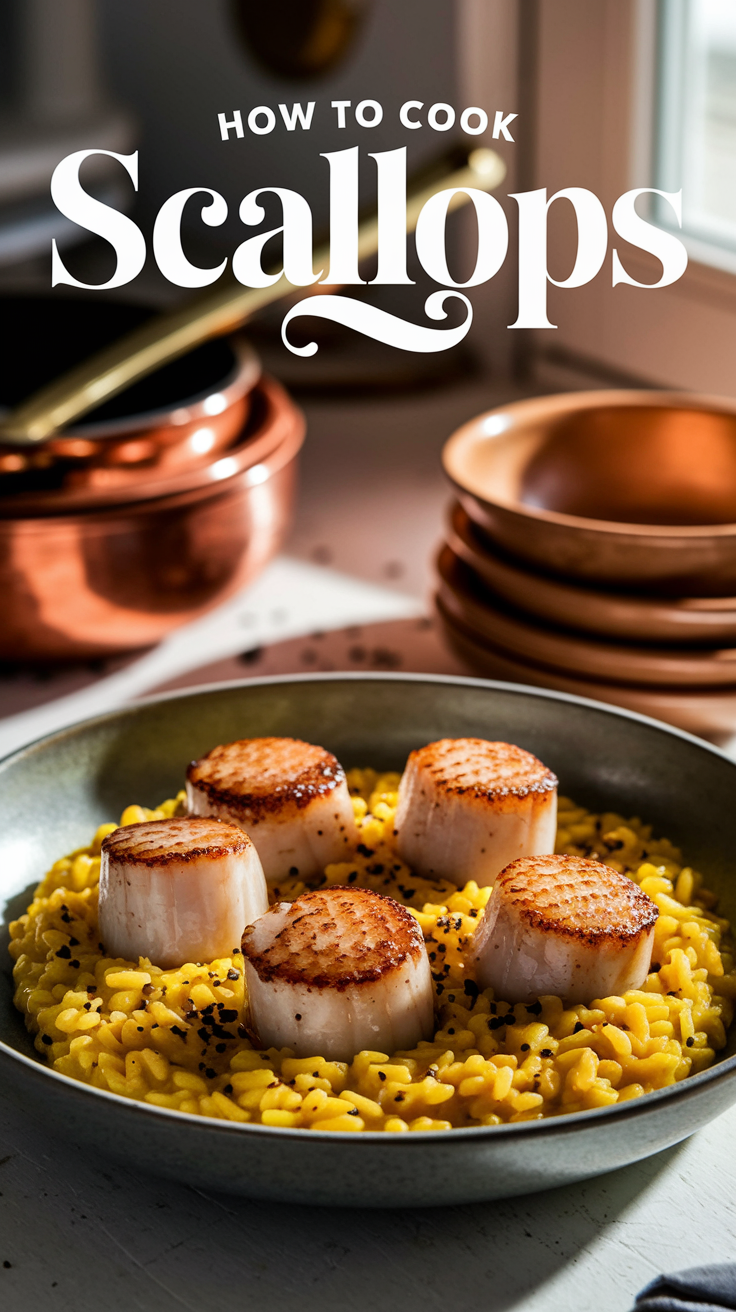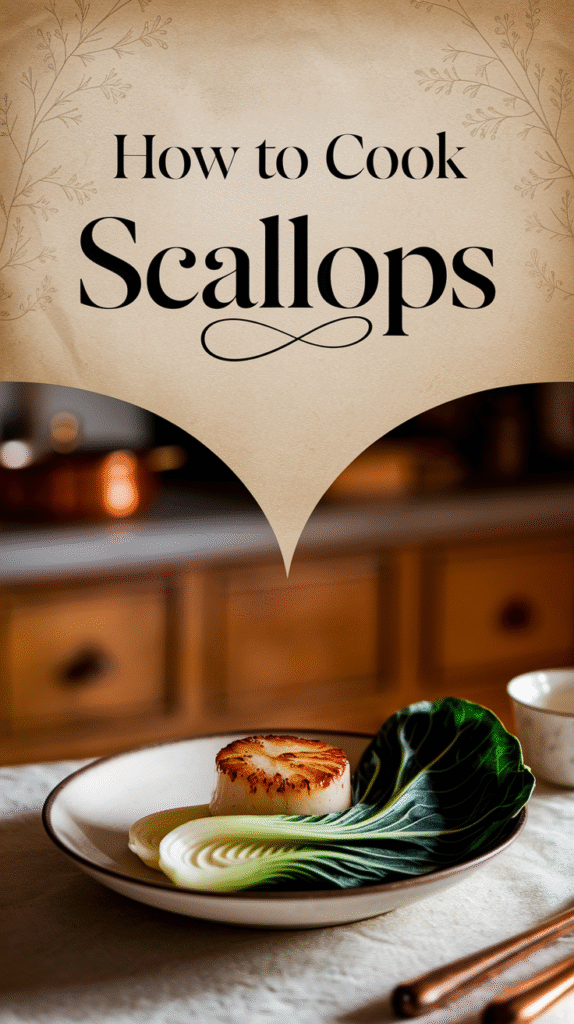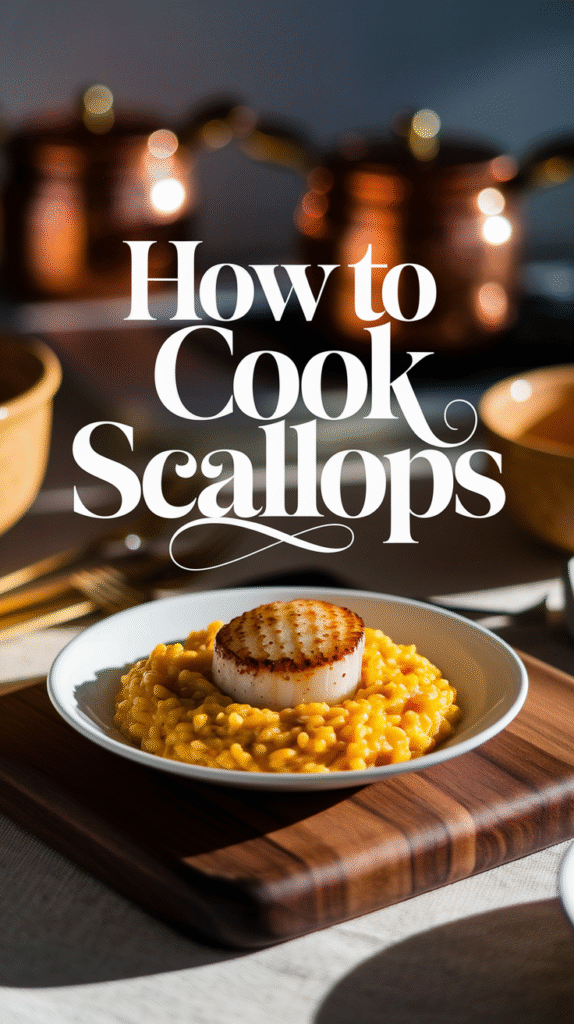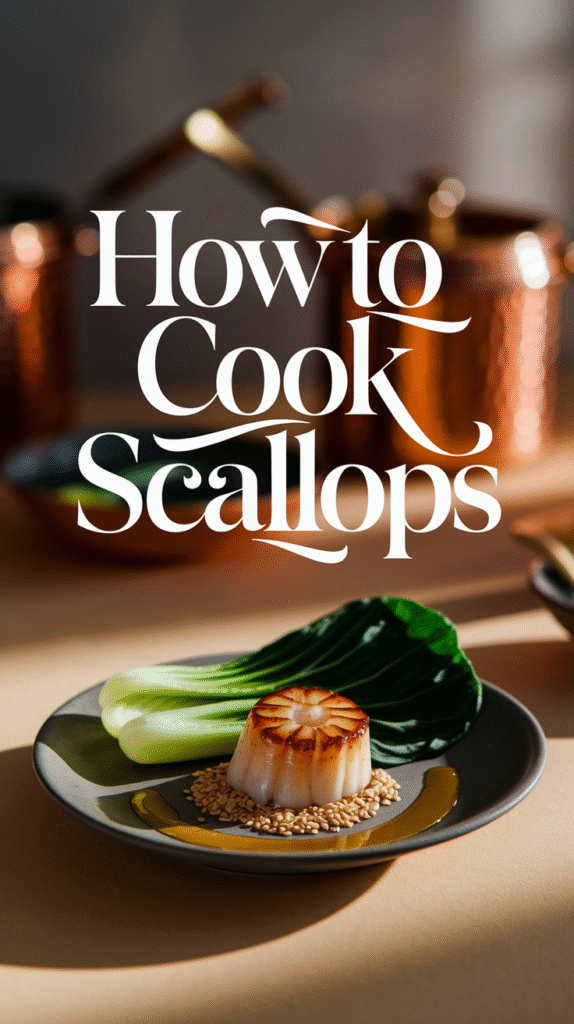If you’re eager to learn how to cook scallops, you’re in for a delicious treat. Scallops are a seafood delicacy, known for their sweet flavor and tender texture. Cooking them is simpler than you might think, and with this step-by-step guide, you’ll impress your family and friends with restaurant-quality scallops right at home.
Choosing Fresh Scallops
Before you begin cooking, it’s essential to select the right scallops. Look for fresh or sustainably sourced options. Here are some tips on what to look for:
- The scallops should smell fresh, with a clean ocean scent. Avoid any with a strong fishy odor.
- Choose scallops that are moist and shiny, not dry or slimy.
- If buying packaged scallops, check the sell-by date to ensure freshness.
Preparing Scallops
Proper preparation is key to achieving the perfect texture when cooking scallops. Follow these steps:
- Thaw Your Scallops: If you purchase frozen scallops, thaw them in the refrigerator overnight or place them in a sealed bag and submerge them in cold water for an hour.
- Pat Dry: Use paper towels to pat the scallops dry. Removing moisture helps them sear better and prevents steaming.
- Remove the Side Muscle: Check for the side muscle, a small rectangular piece attached to the scallop. Gently pull it off, as it can be tough.
Cooking Techniques
There are several methods to cook scallops, each offering unique flavors and textures. Here are three popular techniques you can try:
Searing Scallops
Searing scallops is one of the most common methods, resulting in a perfect golden crust. Follow these steps:
- Heat a skillet over medium-high heat and add a light coating of oil (like olive oil or grapeseed oil).
- Once the oil is hot, place the scallops in the pan. Make sure they are not crowded; cook them in batches if necessary.
- Cook for 2-3 minutes without moving them. Flip when a beautiful crust forms and cook for another 1-2 minutes. They should be opaque and firm to touch.
Grilling Scallops
Grilling adds a smoky flavor to the scallops. Here’s how to do it:
- Preheat your grill to high heat. If using wooden skewers, soak them in water for 30 minutes to prevent burning.
- Carefully thread the scallops onto skewers and brush with olive oil and your favorite seasoning.
- Grill for 2-3 minutes per side until they are opaque and have grill marks.
Baking Scallops
Baking is a great option for a hands-off cooking method. Here’s an easy method:
- Preheat your oven to 425°F (220°C).
- Place scallops in a baking dish and season with salt, pepper, and a drizzle of melted butter.
- Bake for about 12-15 minutes until they are cooked through.
Serving Suggestions
Once your scallops are cooked, it’s time to serve them up! Here are a few ideas:
- Serve over a bed of creamy risotto or pasta for a filling meal.
- Add to a fresh salad for a light and healthy dish.
- Drizzle with a lemon butter sauce for added flavor.
Bonus Tips for Perfect Scallops
To achieve the best results when cooking scallops, consider the following tips:
- Don’t overcrowd the pan; scallops need space to cook evenly.
- Let the scallops rest for a minute after cooking to enhance their flavors.
- Experiment with different marinades or seasonings to find your favorite flavor profile.
Now that you know how to cook scallops, you can enjoy this delicious seafood dish any time. For more delicious seafood recipes and tips, visit Seafood Nutrition or check out Cooking Light’s seafood guides. Happy cooking!
The Best Cooking Techniques for Perfectly Seared Scallops
If you’re looking to cook scallops perfectly, mastering the art of searing is key. Searing creates a delicious golden crust that enhances the natural sweetness of the scallops. Here, we’ll dive into the best techniques to achieve that perfect sear.
Choosing Fresh Scallops
Before you even start cooking, it’s crucial to select quality scallops. Look for:
- Bright, moist, and translucent appearance
- A mild ocean scent
- Organic options when possible to avoid additives
Generally, there are two types of scallops available in stores: bay scallops and sea scallops. Bay scallops are smaller and sweeter, while sea scallops are larger and firmer, making them ideal for searing.
Preparation Steps
To achieve perfectly seared scallops, follow these essential preparation steps:
- Thawing: If frozen, allow scallops to thaw in the refrigerator overnight or place them in a sealed bag and submerge in cold water for about an hour.
- Drying: Use paper towels to pat the scallops dry. This step prevents steaming during cooking, ensuring a crispy exterior.
- Seasoning: Season the scallops simply with salt and pepper. This basic seasoning lets their natural flavor shine.
Choosing the Right Cooking Fat
The type of fat you use plays a significant role in achieving a good sear. Here are a few options:
- Butter: Offers great flavor but has a lower smoke point, so combine it with oil for higher heat capacity.
- Olive Oil: Good choice for its flavor and higher smoke point.
- Vegetable Oil: Neutral taste and higher smoke point, perfect for searing.
Cooking Methods
There are several effective methods for cooking scallops. Here are two popular ones:
Pan-searing
To pan-sear scallops, follow these steps:
- Heat a non-stick or cast-iron skillet over medium-high heat.
- Add two tablespoons of oil and allow it to heat until shimmering.
- Place the scallops in the skillet, ensuring they don’t touch each other. Overcrowding will lead to steaming rather than searing.
- Cook for about 2-3 minutes without moving them, until a golden crust forms. Flip and cook for an additional 1-2 minutes.
Grilling
Grilling scallops can add a unique smoky flavor. To grill scallops, follow these steps:
- Preheat the grill to medium-high heat.
- Skewer the scallops with metal or soaked wooden skewers to prevent them from falling through the grates.
- Brush them lightly with oil and season.
- Grill for about 2-3 minutes per side until they are opaque.
Temperature Check
For perfectly cooked scallops, aim for an internal temperature of 125°F (52°C) for a moist, tender result. Use a meat thermometer for the best accuracy. Remember, scallops will continue cooking slightly after being removed from heat, so take them off just before reaching this temperature.
Serving Suggestions
Scallops can be served in various ways. Here are a few ideas to elevate your dish:
- Pair them with a simple lemon-garlic butter sauce.
- Serve atop a bed of risotto or pasta.
- Top with fresh herbs like parsley or chives for added flavor.
To dive deeper into cooking scallops, check out more resources at Saveur or Serious Eats.
By following these techniques and tips, you’ll be well on your way to mastering the art of cooking scallops. With just a bit of practice, you can create a dish that impresses family and friends alike!
Flavor Pairings: What Goes Well with Scallops?
When you set out to cook scallops, selecting the right flavor pairings can elevate your dish to a whole new level. These delicate, sweet morsels are versatile and can complement a variety of ingredients. Here’s a look at some fantastic flavors that work harmoniously with scallops.
Herbs and Spices
Herbs and spices add depth and complexity to the natural sweetness of scallops. Here are some excellent choices:
- Parsley: Fresh parsley provides a bright, earthy flavor.
- Basil: The sweet and slightly peppery taste of basil enhances scallops beautifully.
- Dill: Its floral notes work perfectly when paired with a citrus sauce.
- Garlic: A classic pairing; minced garlic adds a savory punch.
- Paprika: Smoky paprika gives an exciting twist, especially when sautéed.
Citrus Elements
Citrus fruits are a fantastic way to brighten up your scallop dishes. Consider these options:
- Lemon: Fresh lemon juice or zest cuts through the richness of the scallops.
- Lime: A splash of lime can add a zesty flavor that wakes up the palate.
- Orange: The mild sweetness of orange complements the scallops well, especially in a sauce.
Sauces and Oils
Choosing the right sauce or oil can enhance the natural flavors of scallops. Popular options include:
- Brown Butter: Nutty and rich, brown butter is a luxurious pairing.
- Chive Cream Sauce: This sauce adds a touch of creaminess and fresh flavor.
- Pesto: Using basil or sun-dried tomato pesto gives an Italian twist.
- Chili Oil: Spicy, fragrant chili oil can add a kick to your scallops.
Vegetables
Pairing scallops with the right vegetables creates a fresh and vibrant dish. Here are some of the best vegetables to consider:
- Asparagus: The slightly grassy flavor of asparagus complements scallops nicely.
- Spinach: Lightly sautéed spinach adds color and nutrients.
- Corn: Sweet corn kernels can enhance the sweetness of scallops.
- Peas: Fresh peas provide sweetness and a pop of color.
Tying It All Together
To create a cohesive dish, consider how these flavor pairings can come together. For example, a recipe featuring scallops with lemon, garlic, and asparagus can offer a fresh, bright meal. Alternatively, pair scallops with brown butter, chive cream sauce, and sautéed spinach for a rich and indulgent experience.
Wine Pairings
If you are enjoying scallops with a glass of wine, here are great choices:
- Sauvignon Blanc: The citrus notes of Sauvignon Blanc perfectly balance the sweet flavors of scallops.
- Chardonnay: An oaky Chardonnay complements seared scallops wonderfully.
- Pinot Grigio: Crisp and refreshing, making it a perfect match.
Experimenting with Global Flavors
Don’t hesitate to explore international flavors to enrich your scallop dishes:
- Asian Influence: Try a soy sauce-based glaze with ginger and sesame for an umami kick.
- Latin Flavors: Lime, cilantro, and a hint of jalapeño can create an exciting ceviche or salsa.
- Mediterranean Style: Pair scallops with olives, tomatoes, and feta for a vibrant twist.
These complementary flavors can turn a simple scallop dish into a gourmet experience. For recipes and additional inspiration, you can explore sites like Food Network and Serious Eats. Enjoy experimenting with these pairings and let your culinary creativity flow!
Common Mistakes to Avoid When Cooking Scallops
Cooking scallops can be a delightful experience, but it’s also easy to make mistakes that can ruin the dish. Being aware of these common pitfalls can help you achieve perfectly cooked scallops every time. Here are some key mistakes to dodge when cooking scallops.
Ignoring the Quality of the Scallops
Quality matters when it comes to scallops. Always choose fresh scallops if possible. Look for firm, glossy scallops with a sweet ocean scent. Avoid any that have a strong fishy odor or appear dull. When in doubt, refer to reputable sources such as Seafood Watch for advice on sourcing sustainable seafood.
Not Properly Thawing Frozen Scallops
If you purchase frozen scallops, you need to thaw them safely. Do not simply leave them out at room temperature. Instead, transfer them to the refrigerator overnight. As a faster alternative, seal them in a plastic bag and submerge that bag in cold water for about an hour. This method ensures even thawing without compromising texture.
Skipping the Drying Step
One critical mistake is cooking scallops without drying them first. Wet scallops won’t sear properly, leading to a rubbery texture. After thawing, pat them dry with paper towels. This simple step sets the stage for a beautiful golden crust, better flavor, and improved overall presentation.
Overcrowding the Pan
When cooking scallops, give them space in the pan. Overcrowding can lower the pan’s temperature, preventing a good sear. Instead, cook in batches. This approach allows each scallop enough room to cook thoroughly and develop that sought-after caramelization. Aim for about 2-3 scallops per medium-sized skillet, depending on size.
Using Low Heat
Scallops require high heat for cooking. Using low heat can cause them to steam rather than sear, resulting in a less desirable texture. Preheat your pan on medium-high heat before adding oil. Once it shimmers, add the scallops. Cook them for about 2-3 minutes on each side, depending on size, for a beautifully browned exterior and tender interior.
Overcooking the Scallops
Scallops cook quickly and can become rubbery if overcooked. Aim for a golden brown color with a slight translucence in the center. Use an instant-read thermometer to check for doneness; they are perfectly cooked at around 125°F (52°C). Timing varies based on size and heat, so keep a close watch!
Neglecting Seasoning
Don’t overlook seasoning your scallops. A simple sprinkle of salt and pepper can enhance their natural flavors. For added flair, consider using additional ingredients like garlic, lemon zest, or fresh herbs. These elevate your dish without overshadowing the scallops’ delicate taste.
Pairing Incorrectly
Complements matter when serving scallops. Accompany them with light, fresh flavors, such as citrus, herbs, or light sauces. Heavy sauces can overpower the dish. Consider a lemon-butter sauce, a simple herb vinaigrette, or a light vegetable accompaniment to keep the focus on the scallops.
Not Letting the Scallops Rest
After cooking, give your scallops a moment to rest. This allows juices to redistribute, enhancing the final texture. Just a few minutes on a warm plate can make a difference in the taste and juiciness of your scallops.
Failing to Experiment
Cooking is an artistic process, and scallops are versatile. Try different cooking methods, like grilling or baking, besides pan-searing. Incorporate diverse marinades or glazes, inviting creativity into your cooking. Discovering new flavors can enhance your culinary repertoire.
By avoiding these common mistakes, you’ll be on your way to enjoying perfectly cooked scallops. Always strive for freshness, pay attention to cooking times, and don’t be afraid to experiment. Perfecting scallops can transform your dining experience, making it special every time. For more in-depth culinary tips, explore resources like Culinary Hill.
Nutritional Benefits of Incorporating Scallops into Your Diet
Scallops are more than just a delicious seafood option; they pack an impressive nutritional punch that can benefit anyone looking to maintain a healthy diet. Known for their delicate texture and sweet, buttery flavor, these shellfish are rich in essential nutrients that can support overall well-being. If you’re contemplating adding scallops to your meals, here’s what you should know about the health benefits they offer.
Nutritional Profile of Scallops
When considering a seafood choice, scallops stand out for their nutrient density. A 3-ounce serving of cooked scallops provides:
| Nutrient | Amount | % Daily Value |
|---|---|---|
| Calories | 94 | 5% |
| Protein | 20g | 40% |
| Fat | 1g | 2% |
| Carbohydrates | 0g | 0% |
| Sodium | 358mg | 15% |
| Vitamin B12 | 2.8mcg | 117% |
| Iron | 0.9mg | 5% |
High in Protein
One of the standout attributes of scallops is their high protein content. With 20 grams of protein in just a small serving, scallops can help you meet your daily protein needs. Protein is crucial for muscle repair, immune function, and maintaining a healthy metabolism. scallops into your diet can make it easier to reach your protein goals without excessive fat or calories.
Low in Fat and Calories
If you’re watching your caloric intake, you’ll appreciate that scallops are low in calories and fat. This makes them an ideal choice for a lighter meal without sacrificing flavor. You can enjoy scallops grilled, sautéed, or even baked, making them a versatile option for various dishes.
Rich in Vitamins and Minerals
Scallops are not only beneficial because of their macronutrients; they also provide important vitamins and minerals that can contribute to overall health:
- Vitamin B12: Essential for nerve function and the production of DNA and red blood cells.
- Iron: Vital for transporting oxygen in the blood and preventing anemia.
- Zinc: Supports the immune system and helps wounds heal.
Omega-3 Fatty Acids
While scallops are lower in fat compared to many other seafood options, they do contain small amounts of heart-healthy omega-3 fatty acids. Omega-3s contribute to heart health by reducing inflammation and improving blood circulation. Regular consumption of omega-3-rich foods can help lower the risk of chronic diseases, making scallops a smart addition to your meals.
Potential Health Benefits
Adding scallops to your diet may offer several health benefits:
- Heart Health: The presence of omega-3s and low saturated fat contributes to a healthier cardiovascular system.
- Weight Management: High protein and low-calorie content can aid in weight loss by increasing satiety.
- Immune Support: Rich in essential nutrients, scallops can support a healthy immune system.
If you’re looking to make scallops a regular feature in your meals, consider incorporating them into salads, pasta dishes, or as a lean protein option in a stir-fry. For more delicious recipes and further nutritional information, check out Seafood Nutrition and Eatwell 101.
Scallops are a nutrient-rich seafood option, offering numerous health benefits without piling on calories. By including scallops in your diet, you can enjoy a flavorful, versatile food that supports your health goals. So, next time you’re planning a meal, consider reaching for this delicious shellfish. Your body will thank you!
Conclusion
Cooking scallops successfully requires a combination of technique, flavor knowledge, and awareness of common pitfalls. By following the step-by-step guide outlined in this article, you can achieve perfectly seared scallops that have a delightful texture and mouth-watering taste. Remember, the best cooking techniques—like pan-searing or grilling—highlight the delicate flavor of the scallops.
Pairing scallops with complementary flavors elevates your dish even further. Ingredients like lemon, garlic, and fresh herbs can enhance the natural sweetness, making every bite a gastronomic delight.
However, it’s crucial to avoid common mistakes, such as overcrowding the pan or overcooking the scallops, as these can lead to a rubbery texture and less flavor. By being conscious of these errors, you will preserve the freshness and juiciness of the scallops, ensuring a restaurant-quality result at home.
In addition to being a culinary gem, scallops offer numerous nutritional benefits. They are rich in protein, low in calories, and boast essential minerals like magnesium and potassium, making them a healthy choice for a balanced diet.
By incorporating scallops into your meals, not only can you enjoy exquisite flavors, but you’ll also be nourishing your body. Whether you’re preparing a simple weeknight dinner or an elegant dish for guests, cooking scallops can be a rewarding experience that impresses the palate and contributes to your health. Embrace these tips, and you’ll be on your way to serving up scallops like a true expert.







Leave a Reply